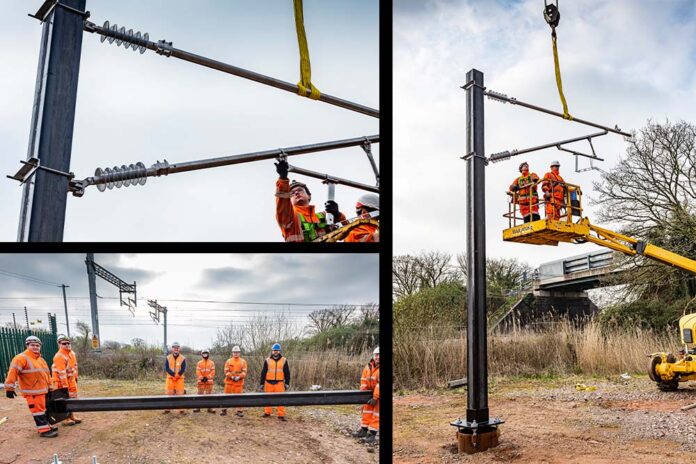An innovative ‘composite’ rail mast, promising to reduce the costs and carbon emissions of building electrified railways, has been unveiled at a Network Rail site near Newport.
The new mast weighs about 450 kilogrammes less than an equivalent steel mast, whilst retaining a similar strength. Such a mast would normally weigh about 750 kilogrammes, have a more carbon-intensive production and often need deep piling or a concrete foundation. It would also, its creators say, require greater energy use in transportation and installation.
Made using advanced composite materials, the unveiling of the new mast could mark the start of a potential move away from galvanised steel in supporting overhead line equipment. It aims to offer a greener and cheaper way to electrify the rail network and secure the benefits of electrification more rapidly.
The project was one of 30 winners of Innovate UK’s First-of-A-Kind 2021 rail competition, funded by the Department for Transport.
Development of the mast brought together public transport electrification engineers, Furrer+Frey, with teams at Cranfield, Southampton and Newcastle Universities and composite materials manufacturer, Prodrive Composites, as well as rail technology developers, TruckTrain.
The mast will now undergo extensive testing to understand the full scope of its capabilities.
It is hoped the product may be used on future electrification projects in the UK and hold major export potential for British industry.
With embedded smart sensors, the masts send data back to owners to inform maintenance schedules, reducing the need for manual, line-side checks and delivering efficiency savings over its lifetime.
The test site is adjacent to the Great Western Mainline between Cardiff and London Paddington, which was recently brought into electric operation with the completion of the 6.4 kilometre Severn Tunnel electrification project in June 2020.
Richard Stainton, electrification engineering expert at Network Rail, said: “It is great to see the industry making strides in this direction, bringing cutting-edge composites to rail.
“Composites could offer Network Rail many benefits, and this project is helping us understand where they can be of most value.
“We have already been using composites in some facilities and structures, so masts seem like a natural next step.
“Given the number of masts we expect to be required in coming years, there is huge scope for composite masts to play a role as we electrify more parts of the network.”
Noel Dolphin, director of UK projects at Furrer+Frey, said: “Masts are a crucial but overlooked feature of our railways. The masts we used today are hardly changed from those used 100 years ago.
“Using modern composite materials, we believe we can slash the embedded carbon of this vital piece of infrastructure.
“By reducing the already short carbon payback period of rail electrification, and reducing the upfront investment required, we aim to accelerate the transition to a greener, faster and more reliable rail network.”
Jon Horsley, transport systems development manager at Cranfield University said: “In recent decades we’ve seen the aerospace and automotive industries make huge strides in energy efficiency through the use of composites, so it makes total sense to transfer it to the one of our oldest and greenest forms of transport.
“The Advanced Vehicle Engineering Centre at Cranfield University have successfully developed a smart solution that means the mast will be capable of self-detecting damages, therefore reducing downtime and the risks and costs of line-side inspections and maintenance.”







































 0113 2082620
0113 2082620 info@railbusinessdaily.com
info@railbusinessdaily.com 15 Mariner Court, Wakefield WF4 3FL
15 Mariner Court, Wakefield WF4 3FL

